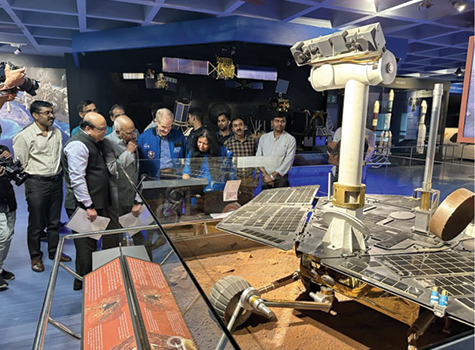
NASA Administrator Bill Nelson interacting with students at “Reaching for the Stars: A Conversation with NASA and ISRO,” event held at the Visvesvaraya Industrial & Technological Museum in Bengaluru on Wednesday, November 29, 2023.
NASA Administrator Bill Nelson encouraged over 200 students during an event entitled, “Reaching for the Stars: A Conversation with NASA and ISRO,” at the Visvesvaraya Industrial & Technological Museum (VITM) in Bengaluru on November 29, 2023. “NISAR is a great example of the strong U.S.-India partnership,” he said.
The event, jointly organized by the U.S. government and VITM, aimed to foster a spirit of curiosity and exploration among the students.
During the engagement, Nelson motivated the students, emphasizing the importance of curiosity, perseverance, and passion in the pursuit of knowledge. Highlighting the ever-growing collaboration between the US and India in the space sector, he said countries can achieve more when they join forces to explore outer space.
“Students across the world are deepening their passion in science and technology, preparing them to be the future innovators and pioneers that help humanity soar to new heights, traverse previously untouched terrain and unlock more secrets of the universe,” said Nelson. “It is an honor to be in Bengaluru where it’s clear that NASA and ISRO’s work together will create possibilities that benefit members of the Artemis Generation in both our countries – and around the world.”
Addressing the students, Former Indian Astronaut Rakesh Sharma said, “As a signatory of the Artemis Accord, I now look forward to a convergence of India’s cultural ethos with NASA’s motto- “For the Benefit of All”.”
Nelson also noted how the upcoming joint NISAR (NASA-ISRO Synthetic Aperture Radar) mission, scheduled for launch in 2024 is just one example of how the U.S. and India’s partnership in space is helping people on Earth. Data from NISAR will help people worldwide better manage natural resources and hazards, as well as provide information for scientists to better understand the effects and pace of climate change.



